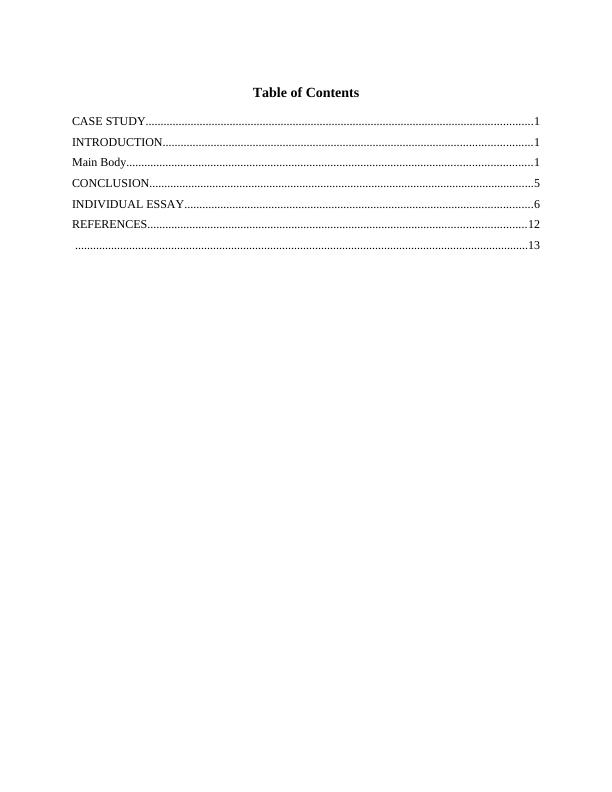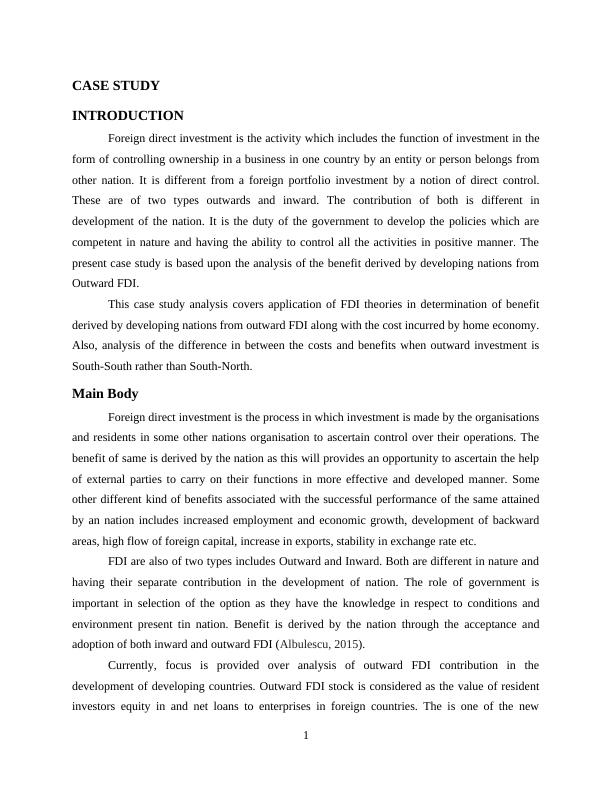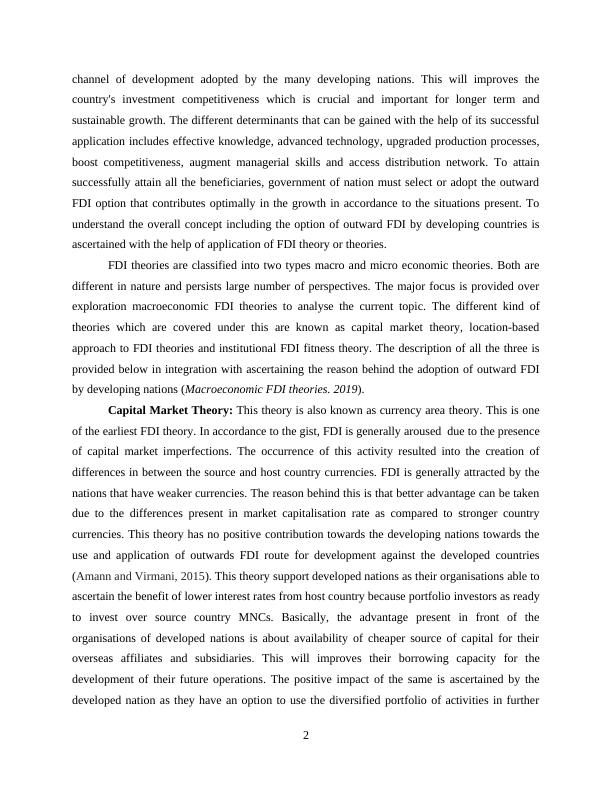Dynamics of a Multinational Company
Added on 2023-01-17
15 Pages4320 Words80 Views
Dynamics of a Multinational
Company
Company

Table of Contents
CASE STUDY.................................................................................................................................1
INTRODUCTION...........................................................................................................................1
Main Body.......................................................................................................................................1
CONCLUSION................................................................................................................................5
INDIVIDUAL ESSAY....................................................................................................................6
REFERENCES..............................................................................................................................12
.......................................................................................................................................................13
CASE STUDY.................................................................................................................................1
INTRODUCTION...........................................................................................................................1
Main Body.......................................................................................................................................1
CONCLUSION................................................................................................................................5
INDIVIDUAL ESSAY....................................................................................................................6
REFERENCES..............................................................................................................................12
.......................................................................................................................................................13

CASE STUDY
INTRODUCTION
Foreign direct investment is the activity which includes the function of investment in the
form of controlling ownership in a business in one country by an entity or person belongs from
other nation. It is different from a foreign portfolio investment by a notion of direct control.
These are of two types outwards and inward. The contribution of both is different in
development of the nation. It is the duty of the government to develop the policies which are
competent in nature and having the ability to control all the activities in positive manner. The
present case study is based upon the analysis of the benefit derived by developing nations from
Outward FDI.
This case study analysis covers application of FDI theories in determination of benefit
derived by developing nations from outward FDI along with the cost incurred by home economy.
Also, analysis of the difference in between the costs and benefits when outward investment is
South-South rather than South-North.
Main Body
Foreign direct investment is the process in which investment is made by the organisations
and residents in some other nations organisation to ascertain control over their operations. The
benefit of same is derived by the nation as this will provides an opportunity to ascertain the help
of external parties to carry on their functions in more effective and developed manner. Some
other different kind of benefits associated with the successful performance of the same attained
by an nation includes increased employment and economic growth, development of backward
areas, high flow of foreign capital, increase in exports, stability in exchange rate etc.
FDI are also of two types includes Outward and Inward. Both are different in nature and
having their separate contribution in the development of nation. The role of government is
important in selection of the option as they have the knowledge in respect to conditions and
environment present tin nation. Benefit is derived by the nation through the acceptance and
adoption of both inward and outward FDI (Albulescu, 2015).
Currently, focus is provided over analysis of outward FDI contribution in the
development of developing countries. Outward FDI stock is considered as the value of resident
investors equity in and net loans to enterprises in foreign countries. The is one of the new
1
INTRODUCTION
Foreign direct investment is the activity which includes the function of investment in the
form of controlling ownership in a business in one country by an entity or person belongs from
other nation. It is different from a foreign portfolio investment by a notion of direct control.
These are of two types outwards and inward. The contribution of both is different in
development of the nation. It is the duty of the government to develop the policies which are
competent in nature and having the ability to control all the activities in positive manner. The
present case study is based upon the analysis of the benefit derived by developing nations from
Outward FDI.
This case study analysis covers application of FDI theories in determination of benefit
derived by developing nations from outward FDI along with the cost incurred by home economy.
Also, analysis of the difference in between the costs and benefits when outward investment is
South-South rather than South-North.
Main Body
Foreign direct investment is the process in which investment is made by the organisations
and residents in some other nations organisation to ascertain control over their operations. The
benefit of same is derived by the nation as this will provides an opportunity to ascertain the help
of external parties to carry on their functions in more effective and developed manner. Some
other different kind of benefits associated with the successful performance of the same attained
by an nation includes increased employment and economic growth, development of backward
areas, high flow of foreign capital, increase in exports, stability in exchange rate etc.
FDI are also of two types includes Outward and Inward. Both are different in nature and
having their separate contribution in the development of nation. The role of government is
important in selection of the option as they have the knowledge in respect to conditions and
environment present tin nation. Benefit is derived by the nation through the acceptance and
adoption of both inward and outward FDI (Albulescu, 2015).
Currently, focus is provided over analysis of outward FDI contribution in the
development of developing countries. Outward FDI stock is considered as the value of resident
investors equity in and net loans to enterprises in foreign countries. The is one of the new
1

channel of development adopted by the many developing nations. This will improves the
country's investment competitiveness which is crucial and important for longer term and
sustainable growth. The different determinants that can be gained with the help of its successful
application includes effective knowledge, advanced technology, upgraded production processes,
boost competitiveness, augment managerial skills and access distribution network. To attain
successfully attain all the beneficiaries, government of nation must select or adopt the outward
FDI option that contributes optimally in the growth in accordance to the situations present. To
understand the overall concept including the option of outward FDI by developing countries is
ascertained with the help of application of FDI theory or theories.
FDI theories are classified into two types macro and micro economic theories. Both are
different in nature and persists large number of perspectives. The major focus is provided over
exploration macroeconomic FDI theories to analyse the current topic. The different kind of
theories which are covered under this are known as capital market theory, location-based
approach to FDI theories and institutional FDI fitness theory. The description of all the three is
provided below in integration with ascertaining the reason behind the adoption of outward FDI
by developing nations (Macroeconomic FDI theories. 2019).
Capital Market Theory: This theory is also known as currency area theory. This is one
of the earliest FDI theory. In accordance to the gist, FDI is generally aroused due to the presence
of capital market imperfections. The occurrence of this activity resulted into the creation of
differences in between the source and host country currencies. FDI is generally attracted by the
nations that have weaker currencies. The reason behind this is that better advantage can be taken
due to the differences present in market capitalisation rate as compared to stronger country
currencies. This theory has no positive contribution towards the developing nations towards the
use and application of outwards FDI route for development against the developed countries
(Amann and Virmani, 2015). This theory support developed nations as their organisations able to
ascertain the benefit of lower interest rates from host country because portfolio investors as ready
to invest over source country MNCs. Basically, the advantage present in front of the
organisations of developed nations is about availability of cheaper source of capital for their
overseas affiliates and subsidiaries. This will improves their borrowing capacity for the
development of their future operations. The positive impact of the same is ascertained by the
developed nation as they have an option to use the diversified portfolio of activities in further
2
country's investment competitiveness which is crucial and important for longer term and
sustainable growth. The different determinants that can be gained with the help of its successful
application includes effective knowledge, advanced technology, upgraded production processes,
boost competitiveness, augment managerial skills and access distribution network. To attain
successfully attain all the beneficiaries, government of nation must select or adopt the outward
FDI option that contributes optimally in the growth in accordance to the situations present. To
understand the overall concept including the option of outward FDI by developing countries is
ascertained with the help of application of FDI theory or theories.
FDI theories are classified into two types macro and micro economic theories. Both are
different in nature and persists large number of perspectives. The major focus is provided over
exploration macroeconomic FDI theories to analyse the current topic. The different kind of
theories which are covered under this are known as capital market theory, location-based
approach to FDI theories and institutional FDI fitness theory. The description of all the three is
provided below in integration with ascertaining the reason behind the adoption of outward FDI
by developing nations (Macroeconomic FDI theories. 2019).
Capital Market Theory: This theory is also known as currency area theory. This is one
of the earliest FDI theory. In accordance to the gist, FDI is generally aroused due to the presence
of capital market imperfections. The occurrence of this activity resulted into the creation of
differences in between the source and host country currencies. FDI is generally attracted by the
nations that have weaker currencies. The reason behind this is that better advantage can be taken
due to the differences present in market capitalisation rate as compared to stronger country
currencies. This theory has no positive contribution towards the developing nations towards the
use and application of outwards FDI route for development against the developed countries
(Amann and Virmani, 2015). This theory support developed nations as their organisations able to
ascertain the benefit of lower interest rates from host country because portfolio investors as ready
to invest over source country MNCs. Basically, the advantage present in front of the
organisations of developed nations is about availability of cheaper source of capital for their
overseas affiliates and subsidiaries. This will improves their borrowing capacity for the
development of their future operations. The positive impact of the same is ascertained by the
developed nation as they have an option to use the diversified portfolio of activities in further
2

End of preview
Want to access all the pages? Upload your documents or become a member.
Related Documents
Benefits of Outward FDI in Developing Nationslg...
|15
|4612
|21
Foreign Direct Investmentlg...
|16
|2961
|116
Foreign Direct Investment in Sub-Saharan Africalg...
|14
|3922
|58
Assignment on Foreign Direct Investment (FDI)lg...
|5
|1728
|340
International Business Environment - Sample Assignmentlg...
|32
|7795
|110
International Business Assignment Solution (Doc)lg...
|5
|1098
|163
